Underwater drones are becoming increasingly popular for various applications, but their usage is governed by a complex framework of federal, state, and local laws. Operators must follow strict safety protocols to safeguard both themselves and the marine environment, including pre-dive checks and emergency procedures. Additionally, the impact of these drones on marine ecosystems necessitates careful consideration to mitigate potential disturbances and pollution.
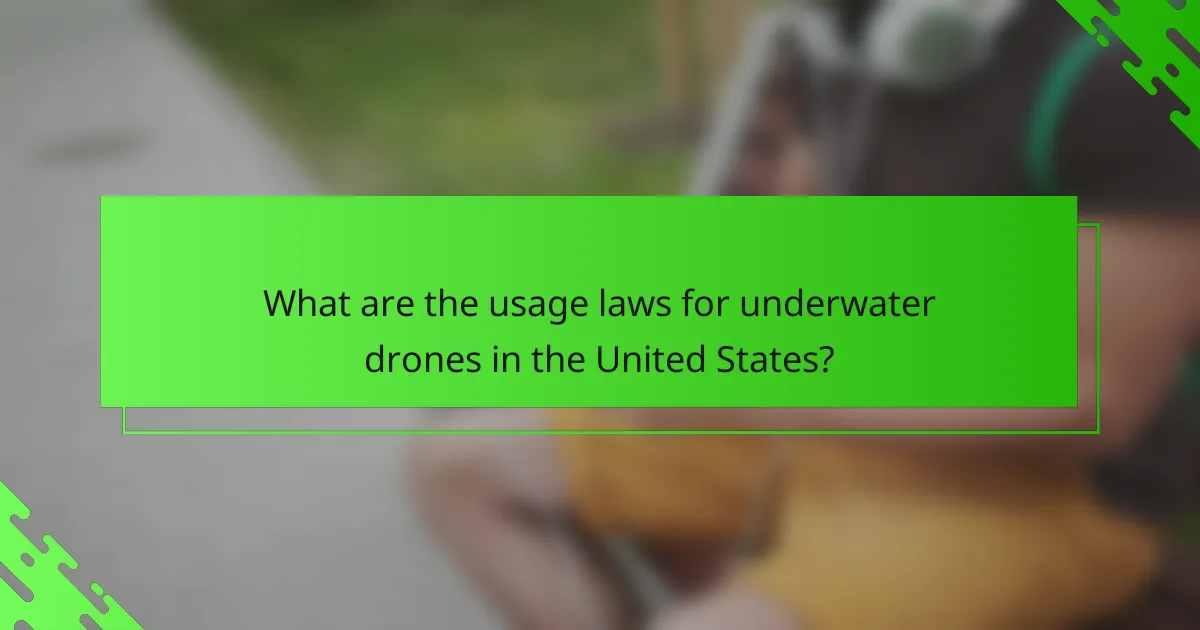
What are the usage laws for underwater drones in the United States?
In the United States, the usage laws for underwater drones vary by federal, state, and local regulations. Operators must comply with guidelines set by federal agencies, as well as specific laws that may apply in their state or municipality.
Federal Aviation Administration regulations
The Federal Aviation Administration (FAA) primarily regulates airspace and does not directly govern underwater drones. However, if an underwater drone is launched from an aircraft or operates in navigable waters, the FAA’s regulations may apply, particularly concerning safety and airspace management.
Operators should ensure that their drones do not interfere with manned aircraft and comply with any relevant airspace restrictions. It’s advisable to check for any updates or changes in regulations that could impact drone operations.
State-specific laws
Each state may have its own set of laws governing the use of underwater drones, often focusing on environmental protection and safety. For example, some states require permits for drone use in certain bodies of water, especially in protected areas or during specific seasons.
Operators should research their state’s regulations, as penalties for non-compliance can include fines or confiscation of equipment. Consulting local wildlife agencies can provide guidance on any specific restrictions related to aquatic life or habitats.
Local ordinances
Local governments may impose additional restrictions on the use of underwater drones, particularly in public parks, lakes, or coastal areas. These ordinances can include designated no-fly zones, time restrictions, or requirements for notifying local authorities before operation.
It’s crucial for operators to check with local authorities or municipal websites to understand any specific rules that may apply in their area. Being aware of local ordinances can help avoid legal issues and ensure responsible drone use.
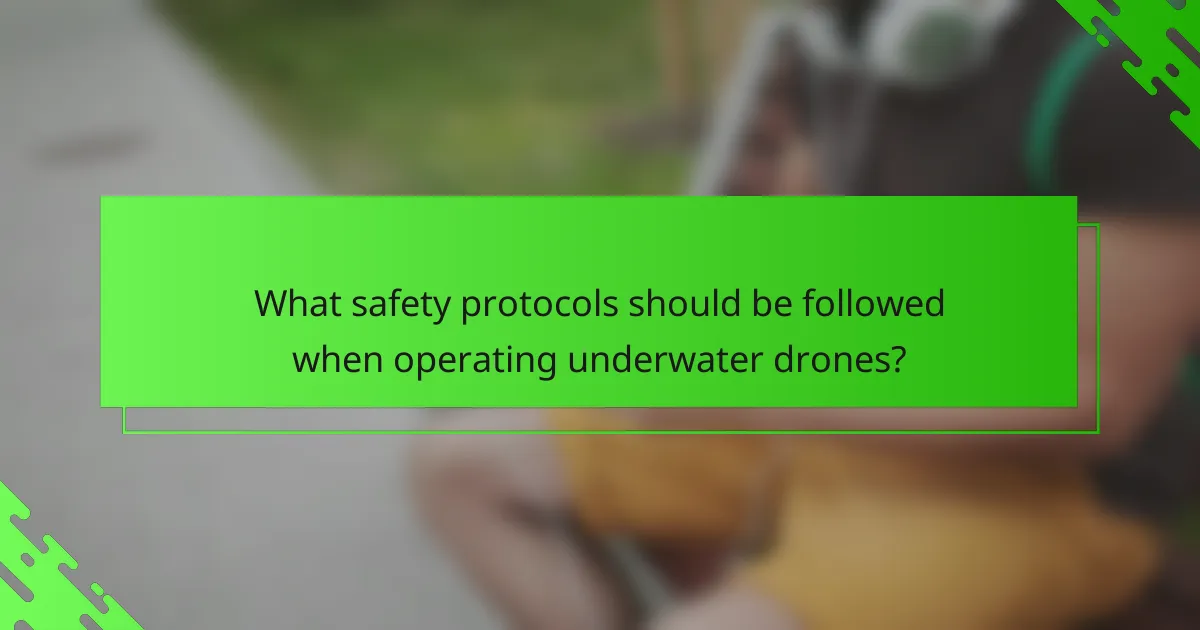
What safety protocols should be followed when operating underwater drones?
When operating underwater drones, it is crucial to adhere to established safety protocols to ensure both personal safety and environmental protection. These protocols include conducting pre-dive safety checks, implementing emergency procedures, and ensuring proper operator training.
Pre-dive safety checks
Before launching an underwater drone, operators should perform thorough pre-dive safety checks to confirm that all systems are functioning correctly. This includes inspecting the drone’s battery levels, ensuring that the propellers are free of debris, and verifying that all communication systems are operational.
Additionally, operators should check the water conditions, including visibility and current strength, as these factors can significantly impact the drone’s performance. A checklist can help ensure that no critical steps are overlooked.
Emergency procedures
Establishing clear emergency procedures is essential for addressing potential issues during a dive. Operators should have a plan for quickly retrieving the drone in case of a malfunction or loss of signal, which may involve using a buoy or a tether system.
Moreover, operators should be trained to respond to various emergencies, such as battery failure or entanglement. Having a communication plan with a support team on the surface can facilitate quick responses and ensure safety.
Operator training requirements
Proper training for underwater drone operators is vital for safe and effective operation. Training programs should cover the technical aspects of the drone, including its controls, navigation systems, and maintenance requirements.
Additionally, operators should receive instruction on safety protocols, emergency procedures, and environmental regulations relevant to their operating area. Certification programs may be available, and completing these can enhance an operator’s skills and confidence.
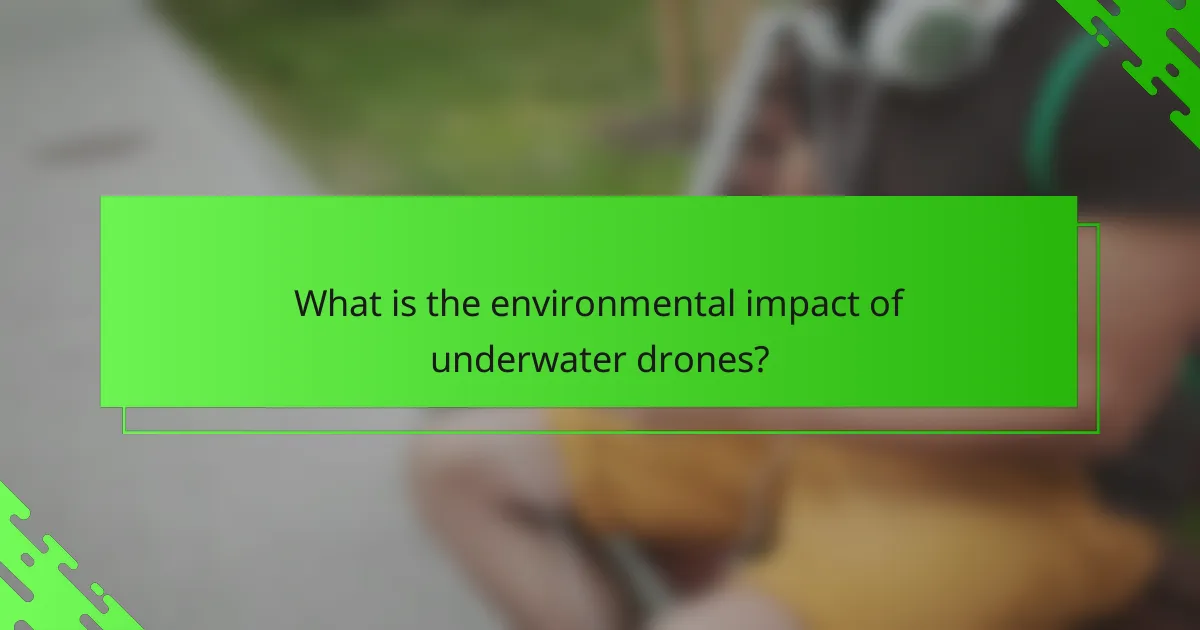
What is the environmental impact of underwater drones?
Underwater drones can significantly affect marine ecosystems, both positively and negatively. Their usage raises concerns about disturbances to marine life, pollution, and the need for regulatory compliance to protect the environment.
Effects on marine life
Underwater drones can disrupt marine habitats, particularly during exploration or research activities. The noise generated by these devices may interfere with the communication and navigation of marine species, such as whales and dolphins. Additionally, the physical presence of drones can alter the behavior of fish and other aquatic organisms.
To mitigate these impacts, operators should limit drone usage in sensitive areas, especially during breeding seasons or in habitats of endangered species. Awareness of local wildlife patterns can help minimize disturbances.
Pollution concerns
Pollution from underwater drones primarily stems from battery leaks and the materials used in their construction. If drones are not properly maintained or disposed of, toxic substances can enter the water, harming marine ecosystems. Regular inspections and responsible disposal practices are essential to prevent such pollution.
Operators should consider using environmentally friendly materials and battery types to reduce their ecological footprint. Adopting best practices for maintenance can also help minimize the risk of pollution.
Regulatory compliance for environmental protection
Many countries have regulations governing the use of underwater drones to protect marine environments. Compliance with these laws is crucial for sustainable operation. For instance, in the United States, the National Oceanic and Atmospheric Administration (NOAA) has guidelines that drone operators must follow to avoid harming marine life.
Operators should familiarize themselves with local regulations and obtain necessary permits before conducting underwater drone activities. Staying informed about changes in environmental laws can ensure responsible usage and contribute to the protection of marine ecosystems.
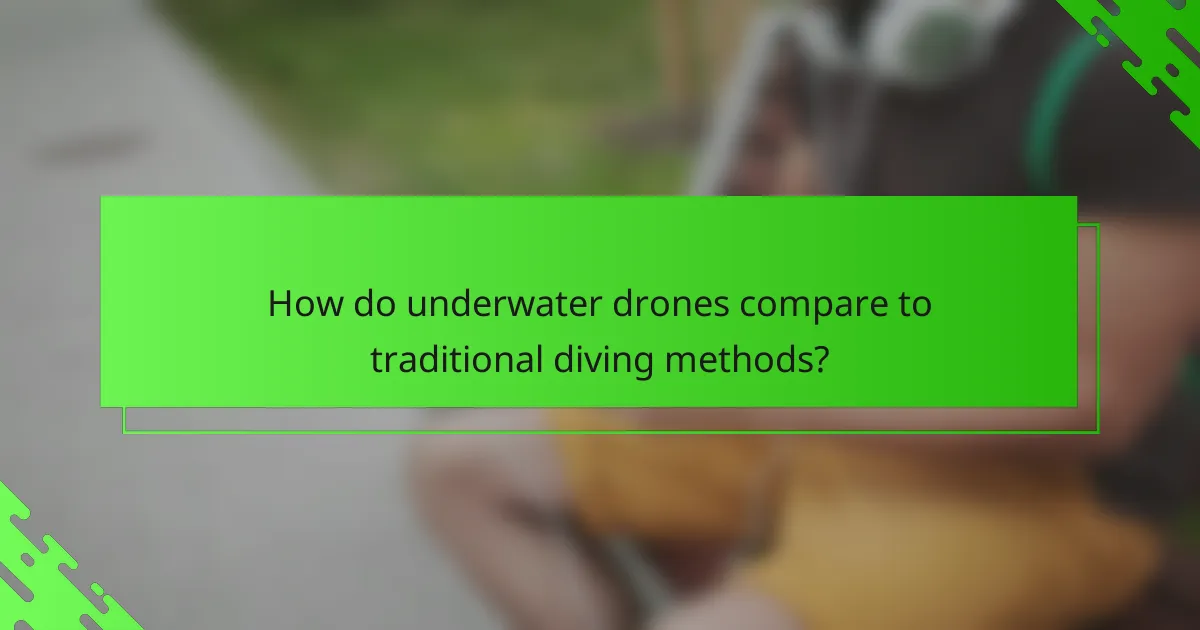
How do underwater drones compare to traditional diving methods?
Underwater drones offer distinct advantages over traditional diving methods, particularly in terms of cost, safety, and operational efficiency. While divers require extensive training and equipment, drones can be deployed quickly and often at a lower overall cost.
Cost-effectiveness
Underwater drones typically have lower operational costs compared to traditional diving. The initial investment in a drone can range from a few hundred to several thousand dollars, depending on the model and features. In contrast, diving gear, training, and safety measures can accumulate significant expenses over time.
Additionally, drones eliminate the need for dive teams, reducing labor costs. For commercial applications, this can lead to substantial savings, making underwater drones an attractive option for inspections and research.
Safety advantages
Using underwater drones significantly enhances safety by minimizing human exposure to hazardous environments. Drones can operate in dangerous conditions, such as strong currents or low visibility, without risking diver safety. This is particularly beneficial in industries like oil and gas, where underwater hazards are prevalent.
Moreover, drones are equipped with advanced sensors and cameras, allowing operators to monitor environments remotely. This capability reduces the likelihood of accidents and injuries associated with traditional diving.
Operational efficiency
Underwater drones can be deployed quickly and operate continuously for extended periods, often lasting several hours on a single charge. This efficiency allows for more extensive data collection and exploration compared to traditional diving, which is limited by air supply and diver fatigue.
Furthermore, drones can be programmed for specific tasks, enabling precise and repeatable operations. This automation streamlines workflows in various applications, from marine research to infrastructure inspections, enhancing overall productivity.

What are the best practices for underwater drone maintenance?
To ensure optimal performance and longevity of underwater drones, regular maintenance is essential. This includes routine inspections, proper battery care, and timely software updates to keep the equipment functioning efficiently.
Regular inspections
Conducting regular inspections is crucial for identifying potential issues before they escalate. Check for any signs of wear and tear, such as damaged propellers, leaks, or corrosion, especially if the drone has been used in saltwater environments.
Establish a schedule for inspections, ideally after every few dives or at least monthly. Document findings and repairs to track the drone’s condition over time, which can help in making informed maintenance decisions.
Battery care
Proper battery care is vital for the performance and safety of underwater drones. Always follow the manufacturer’s guidelines for charging and discharging, and avoid letting the battery drain completely to extend its lifespan.
Store batteries in a cool, dry place and consider using a battery management system to monitor their health. Regularly check for swelling or damage, and replace batteries that show signs of deterioration to prevent malfunctions during operation.
Software updates
Keeping the software of your underwater drone up to date is essential for optimal functionality and security. Manufacturers often release updates that improve performance, fix bugs, and enhance features, so regularly check for available updates.
Set reminders to check for updates at least every few months or after significant usage. Ensure that updates are installed correctly to avoid compatibility issues, and refer to the user manual for specific instructions on the update process.
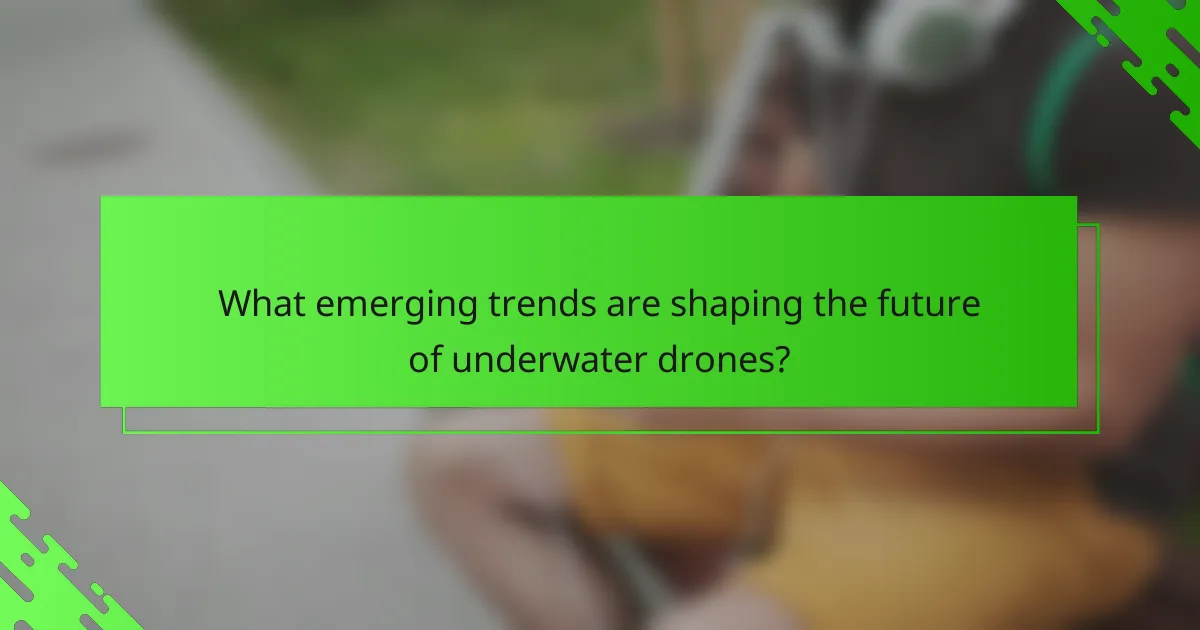
What emerging trends are shaping the future of underwater drones?
Emerging trends in underwater drones include advancements in autonomy, enhanced imaging capabilities, and increased applications in environmental monitoring and exploration. These developments are driving innovation and expanding the use of underwater drones across various sectors.
Usage laws for underwater drones
Usage laws for underwater drones vary by country and region, often governed by maritime regulations and environmental protection laws. Operators must be aware of local regulations regarding drone operation in public waters, including permits and restrictions on specific activities.
In the United States, for example, the Federal Aviation Administration (FAA) oversees airspace regulations, while the National Oceanic and Atmospheric Administration (NOAA) manages marine environments. It’s crucial to check with local authorities to ensure compliance with all applicable laws.
Safety protocols for underwater drone operation
Safety protocols for operating underwater drones include pre-launch checks, maintaining communication, and monitoring battery levels. Operators should conduct thorough inspections of the drone to ensure all systems are functional before deployment.
Additionally, establishing a clear communication plan is essential, especially when operating in remote areas. Keeping a close eye on battery life can prevent loss of control and ensure safe recovery of the drone.
Environmental impact of underwater drones
The environmental impact of underwater drones can be significant, both positively and negatively. On one hand, they can aid in marine research and conservation efforts by providing valuable data without disturbing ecosystems. On the other hand, improper use can lead to disturbances in marine habitats.
To mitigate negative impacts, operators should adhere to best practices such as avoiding sensitive areas during breeding seasons and minimizing noise pollution. Engaging with local environmental organizations can also provide insights into responsible usage and conservation efforts.
